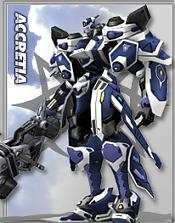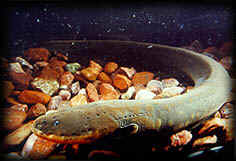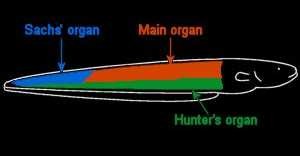Sidat listrik atau belut listrik (Electrophorus electricus) adalah sejenis ikan yang dapat menghasilkan aliran listrik kuat (sampai 650 volt) untuk berburu dan membela diri. Walaupun disebut sidat atau belut, ia termasuk anggota ordo Gymnotiformes, yang tidak mencakup keduanya.
Belut listrik biasa ditemukan di sungai Amazon dan sungai Orinoko serta daerah-daerah disekitarnya. Ia bisa tumbuh hingga panjang 2,5 m (8,2 kaki) dan berat 20 kg (44 pound), walaupun biasanya ukuran rata-ratanya adalah 1 m.
http://id.wikipedia.org/wiki/Belut_listrik
Pertanyaannya, tau sendiri kan apa yang terjadi jika listrik menyentuh air. Tapi si belut listrik menyengat listrik kok airnya gak kenapa-napa?
-
02-01-09, 12:33 #1
 Misteri Belut Listrik
Misteri Belut Listrik
-
The Following User Says Thank You to sariayu For This Useful Post: -
02-01-09, 13:03 #2

pernah baca dulu...di buku mengapa begitu mengapa begini tapi ga kepikir...bisa nyetrum dia ndiri/temennya juga ngga ya....
http://www.sciam.com/article.cfm?id=...tric-eels-gene"let them live in peace among us"

-
02-01-09, 13:31 #3
 Quote of the week:
Quote of the week:

"Indonesia is on the move, get on board." — Forbes Asia
"The optimist proclaims that we live in the best of all possible worlds; and the pessimist fears this is true." James Branch Cabell
Vote for Komodo National Park:
http://www.new7wonders.com/nature/en/vote_on_nominees/
-
02-01-09, 13:45 #4
 HmM... =p
HmM... =p
Memang secara logika kalo dipikir" memang seperti itu..Memang suatu hal yang aneh..
Setau saia, belut listrik tidak akan mempengaruhi air yang ada di sekelilingnya, hanya jika disentuh oleh seseorang, belut listrik baru akan mengeluarkan setrumannya, tapi tetap tidak mempengaruhi air dan biota di sekitarnya..Mungkin itu memang kelebihan dari sang belut listrik ini..HoHo... ^_^
-
02-01-09, 13:50 #5

sumber daya listrik pakek belut gituan bisa ga ya?
lumayan buat cadangan 2012++
-
02-01-09, 13:54 #6

listrik yang di hasilkan ko nda sala hanya kecil sekian volt gtu......
yang masih membuat ku bngung belut listrik dapat mengendalikan listrik nya??
tubuh bagian mana penghasil listrik??
kenapa konsep ini tidak di terapkan dalam pembuatan listrik?
secara skrg byk negara mulai krisi listrik termasuk indonesia
-
02-01-09, 14:08 #7

keknya gw pernah baca kalau disekujur tubuh belut listrik dipenuhi sensor dan jutaan sel yang berfungsi untuk mengalirkan listrik. jadi belut listrik menggunakan seluruh tubuhnya untuk mengalirkan listrik...
selain untuk melindungi dirinya belut listrik menggunakan listrik untuk berkomunikasi dengan belut listrik yang lainnya...
jadi tak heran kalau kita ngeliat belut listrik saling berdekatan dan apabila kita menyentuhnya tangan kita akan tersengat...Spoiler untuk IDGS Story Character :
-
02-01-09, 14:32 #8








- Join Date
- Feb 2008
- Location
- P.R.L 412, Club non homo IDGS!
- Posts
- 1,840
- Points
- 2,228.40
Thanks: 0 / 0 / 0
kalo dipikir2 bener jg yh? air kan konduktor, wedew... tanya master fisika dan biologi ajah
Anti-****, Anti-Indogaymers, Anti cowok suka cowok, Anti sex dgn sesama jenis, tidak ad yang **** disini!
Bergabunglah dgnSpoiler untuk ANTI **** :
-
02-01-09, 15:03 #9

hmm... menurut saya sih....
ini pengaruh range dan durasi.
air memang menghantar listrik.tapi tidak sebaik logam.
durasi sengatan listriknya apabila cmn sekiam milidetik...tentu tidak sampai jauh hantaran listriknya.kecuali binatang sekitar radiusnya, mungkin baru kena."let them live in peace among us"

-
02-01-09, 18:06 #10

dia hanya akan mengeluarkan listrik kalau ada yg mengancam doank kok.. jadi ga setiap saat keluarin listrik..
dan otomatis teman sejenis spesiesnya udah pasti tubuhnya dirancang memiliki imunitas terhadap listrik yg dihasilkan oleh belut listrik tersebut
-
02-01-09, 20:11 #11
-
03-01-09, 20:06 #12

Nih, berbagai fakta (sorry in english)

The electric eel, unlike most electric fish, has three separate organs which it uses for producing a charge. The need for three electric organs is to fulfill the various roles and applications of its ability to produce electricity. The Main and Hunters' organs are the high voltage producers, used for protection, fright reflexes and stunning prey. The Sachs' organ is capable only of producing low voltage pulses - its purpose is mainly electro communication and navigation. The eel, spite being slightly curved in the above picture, tends to remain straight whilst moving, using its anal fin to propel itself. This is necessary in order to maintain a uniform electric field around itself, as a more effective sensory mechanism.

The electric organs, responsible for the discharge, are composed of muscle-like cells called electrocytes. These cells resemble muscle cells in the sense that they exist at the end of axons or nerve cells, as a muscle cell would, only the electrocytes have no contracting ability. Having a distinctly disc like form, the electrocytes can be aligned as cells in a battery.
Up to 200,000 of these cells can be aligned in series within the organ....each one capable of producing a small voltage so that when discharged simultaneously, the resulting potential difference is the sum of each of these voltages. In the low voltage organs, electric discharge varies considerably from fish to fish. Some species produce a continual wave-like discharge, whereas others emit a constant pulse. The higher voltage organs emit a pulse, but they remain inactive most of the time, recharging for a large accumulated discharge in the event of danger.
Electric eels are classified as strongly electric fish as opposed to weakly electric fish, the Torpedo ray is another strongly electric fish. Electric discharge is therefore of the "pulse" like nature.
Electrocytes, like all eukaryotic cells, maintain a potential gradient across the membrane, this is done by active transport of Na+ and K+ ions through membrane pumps, protein structures which span the phospholipid bilayers forming the cell membrane. Transport of these ions is coupled to the synthesis of ATP, the standard currency of energy in all biological organisms.
Jadi intinya gini
Bentuk tubuh belut listrik unik. Hampir 7/8 bagian tubuhnya berupa ekor. Di bagian ekor inilah terdapat baterai-baterai kecil berupa lempengan-lempengan kecil yang horizontal dan vertikal. Jumlahnya sangat banyak, lebih dari 5.000 buah. Tegangan listrik tiap baterai kecil ini tidak besar, tetapi kalau semua baterai dihubungkan secara berderet (seri), akan diperoleh tegangan listrik sekitar 600 volt (bandingkan dengan batu baterai yang hanya 1,5 volt).
Ujung ekor bertindak sebagai kutub positif baterai dan ujung kepala bertindak sebagai kutub negatif. Belut listrik dapat mengatur hubungan antara baterai kecil dalam tubuhnya itu untuk mendapat tegangan listrik kecil dan tegangan listrik besar.
Tetapi ketika ketemu musuh atau mangsanya, belut listrik akan memberikan tegangan semaksimal mungkin melalui kepala dan ekornya yang ditempelkan pada tubuh musuh atau mangsanya itu. Arus listrik sekitar 1 ampere yang ditimbulkan oleh tegangan listrik yang tinggi ini akan mengalir dan membunuh mereka. Hewan lain tidak terganggu karena mereka tidak bersentuhan langsung dengan ekor dan kepala belut.
Kalo, nyetrum semua yang ada di sungai, bisa rusak ekosistemnya, kan? Jadi belut listrik sudah dirancang penciptaannya oleh Tuhan, sehingga tidak membahayakan organisme lain yang tidak sedang "berurusan" dengannya.
-
03-01-09, 23:38 #13

ya yg pasti listrik yg dihasilkan tidak begitu besar donk..
makanya akan sangat jarang ada ikan yg berani dekat2 dengan belut ini..
klo ada predator untuk belut ini pasti predatornya memiliki struktur kulit yg cukup tebal untuk menghindari sengatan..
@quirk
nice info tuh.. keknya uda kejawab ama dia da
-
06-01-09, 05:36 #14
-
06-01-09, 05:50 #15

Sidat listrik atau belut listrik (Electrophorus electricus) adalah sejenis ikan yang dapat menghasilkan aliran listrik kuat (sampai 650 volt) untuk berburu dan membela diri. Walaupun disebut sidat atau belut, ia termasuk anggota ordo Gymnotiformes, yang tidak mencakup keduanya.
Belut listrik biasa ditemukan di sungai Amazon dan sungai Orinoko serta daerah-daerah disekitarnya. Ia bisa tumbuh hingga panjang 2,5 m (8,2 kaki) dan berat 20 kg (44 pound), walaupun biasanya ukuran rata-ratanya adalah 1 m.
Belut listrik sendiri menurut versi saia, belut ini mengeluarkan listrik nya sebagai bentuk perlindungan dari dirinya jika diserang atau merasa terganggu..
tapi jika merasa aman, belut ini akan sama dengan belut lainnya
Meet me at
Indogamers | myMYM | Kaskus | Indowebster | Bunglon.net | Ligagame | Gosugamers | Dragonica
× Gaming Organizer ×















Share This Thread